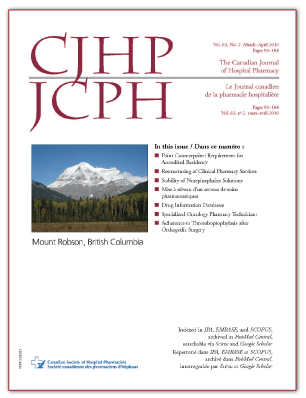Démarche pour la mise à niveau d’un secteur de soins pharmaceutiques : le cas de l’hémato-oncologie pédiatrique
DOI:
https://doi.org/10.4212/cjhp.v63i2.897Keywords:
soins pharmaceutiques, hémato-oncologie, modèle de pratique, pharmaceutical care, hematology–oncology, model of praticeAbstract
RÉSUMÉ
Contexte : Bien que le concept de pharmacie clinique ait été développé dans les années soixante, il existe une grande variété de programmes et une grande disparité entre les programmes en clinique externe et en hospitalisation, bénéficiant de la présence d’un pharmacien dans un secteur de soins.
Objectif : Éprouver une méthode de mise à niveau des secteurs de soins pharmaceutiques en établissement de santé.
Méthode : Il s’agit d’une étude descriptive se déroulant au Centre hospitalier universitaire Sainte-Justine, un établissement mère-enfant de 500 lits. Le secteur de soins pharmaceutiques ciblé pour illustrer la méthode de mise à niveau est l’hématologie-oncologie pédiatrique. La méthode comporte trois étapes, soit une revue de la documentation scientifique, un profil du secteur et une mise à jour du niveau de pratique selon un profil des activités pharmaceutiques dans le secteur avant et après la mise à niveau.
Résultats : Au total, 108 articles ont été recensés et 22 ont été retenus à partir d’une recherche dans PubMed. Après une recherche manuelle complémentaire, 36 articles ont finalement été évalués. Parmi les articles retenus, on compte trois lignes directrices, 11 études de développement, une revue de la littérature scientifique, six études pré- et postinterventions et 15 études quasi expérimentales. Bien que les patients de ce secteur ne comptent que pour 5 % des admissions de l’hôpital, la complexité des cas est élevée tant sur le plan de la codification de l’épisode de soins que du potentiel d’intervention pharmaceutique par admission.
Conclusion : Il existe peu de données illustrant une démarche de mise à niveau de la pratique dans un secteur de soins pharmaceutiques. Cette étude a éprouvé une méthode de mise à niveau dans un service d’hématologie-oncologie pédiatrique et comporte une revue de la documentation scientifique, un profil du secteur et une description des tâches des pharmaciens de ce secteur avant et après la mise à niveau.
ABSTRACT
Background: Although the concept of clinical pharmacy was originally developed some time ago, in the 1960s, there is a wide variety of programs in existence, as well as great disparity between programs where the presence of a pharmacist is provided in outpatient and inpatient settings.
Objective: To test a method for upgrading pharmaceutical care areas in a hospital setting.
Method: This descriptive study was conducted at the Sainte-Justine university health centre, a 500-bed mother-and-child hospital. The pharmaceutical care area that was used to exemplify the upgrading method was pediatric hematology–oncology. A 3-step method was used: review of the scientific literature, creation of a profile of the targeted area, and upgrading of the practice level according to the pre- and post-upgrading profile of the pharmaceutical activities in the area.
Results: A total of 108 articles were identified in a search of the PubMed database, of which 22 were retained. After a complementary manual search, a total of 36 articles were evaluated. The articles retained included 3 guidelines, 11 development studies, 1 review of scientific literature, 6 pre- and post-intervention studies, and 15 quasi-experimental studies. Although patients in the pediatric hematology–oncology area account for only 5% of admissions to this hospital, the cases are highly complex, in terms of both the codification of the care phase and the potential for pharmaceutical intervention per admission.
Conclusion: There are few data to illustrate a method for upgrading practice in a pharmaceutical care area. This study tested a method for upgrading pharmaceutical care in a pediatric hematology–oncology service, with a review of the scientific literature, a profile of the area, and the pharmacists’ pre- and post-upgrading job description in this area.
Downloads
Downloads
Issue
Section
License
Copyright © Canadian Society of Healthcare-Systems Pharmacy.
After publication of a manuscript in the CJHP, the authors of the manuscript must obtain written permission from the CSHP (publications@cshp.ca) before reproducing any text, figures, tables, or illustrations from the work in future works of their own. If a submitted manuscript is declined for publication in the CJHP, all said rights shall revert to the authors. Please note that any forms (e.g., preprinted orders and patient intake forms) used by a specific hospital or other health care facility and included as illustrative material with a manuscript are exempt from this copyright transfer. The CJHP will require a letter from the hospital or health care facility granting permission to publish the document(s).










